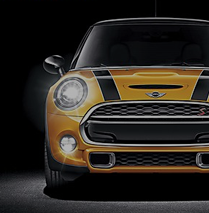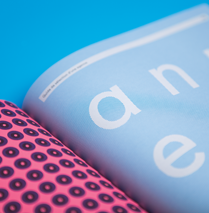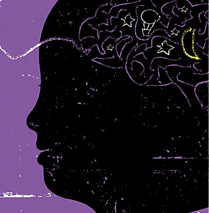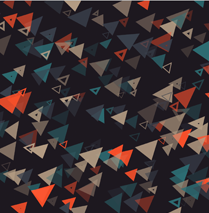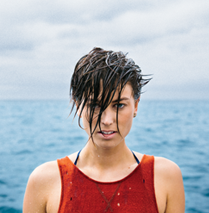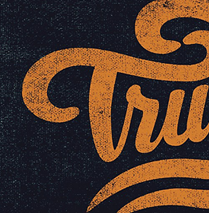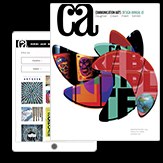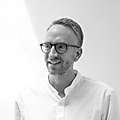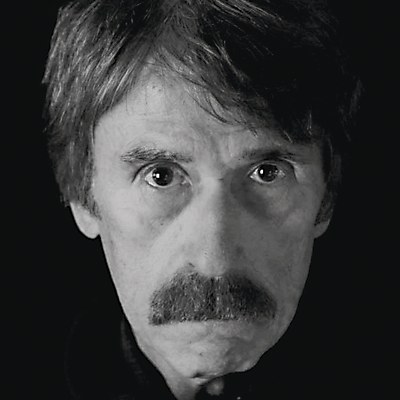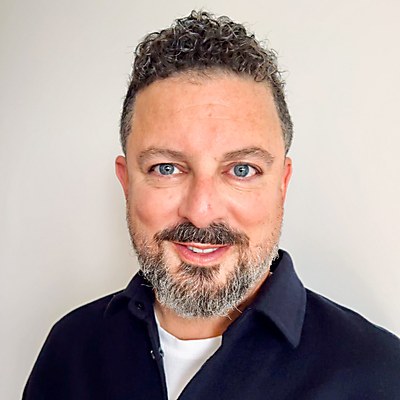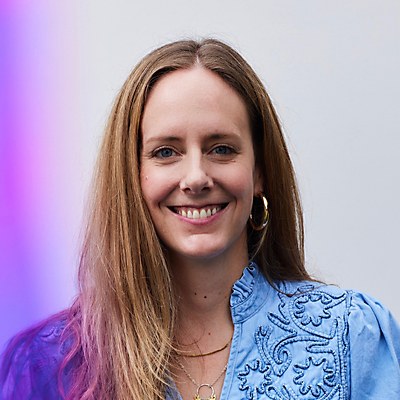How did you discover your passion for design and learn the necessary skills to get started in the field? I always had a passion for creativity. For example, I was really into airbrushing as a kid, using the technique to create surreal, Dali-eqsue pictures or typographic illustrations. At the same time, I loved tinkering with computers—we’re talking the early days of computing here, with a ZX Spectrum and eventually an Atari ST. My mum was a math teacher, so I always had that logic part of my brain switched on. My dad was a carpet fitter, so I get my pragmatic, hands-on approach from him.
As I approached my teens, my sister married a graphic designer. I suddenly realized you could bring computers and art together to make a living—and I became obsessed. I went on to study graphic design at the Surrey Institute in Epsom, United Kingdom, where I graduated from in 2000. Just before studying, though, I applied for some summer jobs at a local industrial estate. One of the places was called the Multi-Media Warehouse. In their interview, they asked if I had heard about the internet—it was 1996—and whether I could do their website. I was given a book the size of a bible to learn HTML from scratch and two weeks to build it.
This was the start of bringing together my love of design and technology. The rest is history.
What led you to establish Wiedemann Lampe with cofounder Benji Wiedemann? What do your typical clients look like, and what do you do there in your role as creative director? While studying, I always dreamed of working at one of the big digital agencies, like Deepend. Every student would flock to Deepend because of the exciting work it was doing. I was offered a job there, but the more I learned about the role, the more limiting it sounded; my approach was multidisciplinary, but the agency encouraged specialization very early on. I wanted something broader and more strategic, which led me to Lewis Moberly. There, I got the chance to have ownership of digital projects while still being able to work on branding, packaging and product design briefs.
This is also where I met Benji. At first, I couldn’t make sense of him—he zags where everyone else zigs. He has a big personality, whereas I have always been relatively quiet, but we became very good friends.
Benji and I worked at Lewis Moberly for a solid few years where we had the incredible direction of Mary Lewis and the creative partners—I always call it my master’s degree. Eventually, though, we began to hit a ceiling. We felt we weren’t getting enough opportunities to take brands to the next level in a digital environment, so we started to work on freelance projects together where we could unite brand and digital through our complementary skills. This was in an era where brand consultations would do the brand, and digital agencies would ask if the logo should go left or right. Certain publications were still sneering at “digital” as a credible medium.
Seventeen years later, Wiedemann Lampe is a strategic brand and business consultancy. Our typical clients are focused on culture, education and placemaking. We are motivated by the potential of brand to empower individuals, build connections between people and the places they live in, influence change, and make a positive contribution to the world—so, these are the types of organizations we gravitate toward. We always say our clients’ primary currency is the exchange of knowledge rather than monetary transactions. This poses its own challenges in that we are always dealing with the intangible to make a real-world impact. Being able to harness the power of the intangible has enabled us to transfer our knowledge to clients across multiple sectors. We also want to ensure that the brands we create lead to real business transformation through internal behavior change and accountability driven by purpose-led organizational culture.
Benji sits very firmly in the creative direction role. His visual vocabulary and knowledge is vast, which makes him extremely inspiring and instinctive as a creative director. He is continually pushing concepts and ideas further to find deeper layers of meaning and relevance for the clients we work with while ensuring we harness the power of brand to transform business strategy.
My role has changed over the years; my background in digital means I concentrate on how the brand plays out across time, how it connects with its audiences, what that experience feels like, and the digital and physical ecosystem needed to enable it. I facilitate most of the workshops and carry out our investigation stages at the beginning of projects. So, my role is really setting the players up on the board. Benji takes it from there. Then, I come back in at the end to turn those ideas into reality through digital experiences. It is very much the combination of mathematics and magic.
Tell us about some of your favorite projects you’ve worked on at Wiedemann Lampe. What did you like about them, and how did they change your perception of what you can achieve with design? Most projects are favorite projects, but there are certain milestone ones. We started working with the Louvre Abu Dhabi in 2019, which has been many projects in one.
We learned our craft in the United Kingdom, working with all the greats—the Imperial War Museum, Kew Gardens, Natural History Museum, Museum of London and Science Museum. But Abu Dhabi did not have a prior museum culture. Our job was to inject that not only into local audiences, but also with the internal teams working there. This is where we learned the power of stakeholder engagement, interviews and workshops to unpack and facilitate discussions around internal bottlenecks—and eventually design processes and toolkits to resolve them.
First, we had to articulate why the museum exists. This was a deductive process, not an additive one. It was about distilling everything we heard into succinct insights to find that human truth and real point of difference: How does the museum change people from when they walk through the doors to when they leave? The answer was to reveal that we have more in common than we know. It does this by telling stories of cultural connections. This became the golden thread for everything the institution does, from the way security guards greet you to the curation to the cultural programming.
The visual identity was the next challenge. It is a trilingual brand, so we had to create a design system that worked with Arabic, English and French. The creative output was driven by a process that resolved some internal bottlenecks. We designed three types of projects for the museum: Fix, Flex and Super-Flex. Each had its own brief, process and guidelines so that it could be turned around from commission to creation from a matter of days to months. By creating a system like this, we create a canvas for the magic to happen.
Next up was the visitor experience. The Louvre Abu Dhabi is an architectural masterpiece designed by Jean Nouvel, inspired by labyrinthine medinas. The architect’s intent was for visitors to “get lost in art.” Unfortunately, this meant visitors weren’t able to find their way to the toilets, café or exit. This process pushed us into thinking of creative solutions for wayfinding built from logic but expressed with a lightness that weaved into the building’s fabric.
Whenever we speak to students, we talk about the importance of stepping outside your comfort zone. This was one of those projects. The lessons we learned from this acted as a catalyst to much larger projects and informed the way we work today for complex organizations.
As someone who has a strong interest in science, you often like to incorporate scientific concepts in your design and take an equally right-brained and left-brained approach to creativity. What does this process look like for you? Science has always fascinated me. While I’m not an expert, I enjoy understanding how things work conceptually. I’m naturally curious and have books on evolutionary biology, quantum physics, multiple universes and philosophy. I’m particularly intrigued by the ongoing challenge in physics to develop a single theory that can explain all the fundamental forces of nature, including gravity, electromagnetism and the nuclear forces. Explaining some of these theories requires thinking in multiple dimensions. For instance, Calabi–Yau spaces are shapes used to describe the extra dimensions of spacetime. This kind of stuff really appeals to me.
Before the proliferation and hype around all the AI models like ChatGPT, I was learning how neural networks work and doing online courses in machine learning and coding in Python. I guess I like to understand how things work from first principles.
How does this help my design work? Well, it’s about increasing your conceptual vocabulary. If these ideas are somewhere in your mind and you’re thinking about a complex problem, sometimes an idea can emerge that comes from some of these areas. For instance, we were working on a complex brand architecture for a city scale development. The traditional linear models of brand architecture just didn’t fit—so, we came up with molecular structure that was much more appropriate for the nuances of a city. It used ideas such as the core building blocks of DNA to introduce traits and mutations that could lead to multiple outcomes yet were still anchored in a familiarity and cohesion.
For designers who might be curious about similarly incorporating science concepts into their work, what would you say the advantages of this process are, and where would you suggest they start learning? It’s about having a different starting point and frame of reference. When you have been in design for so long you start to see patterns emerging. The problem is that design is self-referential. The starting point for new work is often other people’s work. Then there are the macrotrends—for example, the move from skeuomorphic to flat design, and then back to a form of semi-skeuomorphism.
Design shouldn’t be trend driven. It should be driven from the specificity of the challenge you are solving. We can stand on the shoulders of giants, but why not try standing with a different crowd of giants?
If you want to start learning, you need to start somewhere you are going to be inspired. I have been a long-time subscriber to National Geographic, New Scientist and WIRED magazine. Every monthm I will come across something that amazes me. You don’t know what you don’t know.
What technological innovations are you most excited about or have the most potential to transform how you approach design? When I was studying 20 years ago, I was very focused on spatial digital design. I wanted to challenge the way interfaces were designed. Screens have always represented space. We watch movies and we are immersed in dimensional worlds. So, why design websites like they were flat surfaces?
I won the D&AD student award 24 years ago for a product design brief which preempted what Apple is doing with Vision now. At the time, it was fantasy, but now it is becoming closer to reality. The potential is very exciting in thinking about how digital interfaces can interact with our physical environment. There are still some hardware challenges to be solved though. No one will want to walk around caged inside a mask, but I think those devices will start to reduce in size and start to gain social acceptance.
From where do you seek inspiration these days? I’m continually inspired by the clients and the people we work with. We work with huge organizations, with people at the top of those organizations, in fields and territories we are sometimes new to. You become experts very quickly in fascinating subjects.
During lockdown, we built a digital workshopping tool that would enable us to run in-depth strategic, creative and user experience workshops through the browser. We’re continually building new modules to help solve very specific human-shaped problems. Against the backdrop of AI this has been instrumental to our process in bringing people together to gather and reveal insights. The tools that we build and the results that they yield are what keeps me inspired.
What is the biggest challenge currently facing designers and other creatives? The elephant in the room is AI. For now, AI is good at tasks, but not projects. Designers would be foolish to ignore it. My brother-in-law always talked about illustrators that he knew that got left behind because they didn’t embrace the Mac. When I was studying design, I recognized the potential of the internet, then in its infancy, and learned to code so that I could express myself in a digital environment.
Today’s designers should be asking how they can embrace AI to amplify their abilities. More importantly, we need to become better at the things AI can’t do—the thinking, the strategy, the tinkering that leads to happy accidents, finding the nuances that lead to personality, humor and memorability. ca


